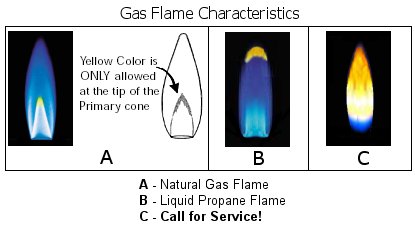One of the subjects that always gets home inspectors debating is vent free, or ventless fireplaces. These are inserts or free standing units that burn natural gas (or in some cases propane), yet require no venting to the exterior.
With proper installation, maintenance and operation, some can burn with as much as 99.9% efficiency. A proper burning flame will release very little byproducts, which are the main problem when these units are not operating correctly. A proper flame will have a inner blue flame, surrounded by a slightly larger flame. In the chart below, you can see the difference between a properly adjusted flame (A), and a poorly adjusted flame (C). This also applies to your furnace, hot water tank etc.

What's bad about vent less fireplaces, is that if the flame is not properly adjusted, it is creating a combustion hazard that is trapped in your home. Fro this reason, they are illegal in some states. They can deplete oxygen and create carbon monoxide if not properly installed and in good working order. Most units will have an oxygen depletion sensor. Another unwanted byproduct of combustion is moisture, and this can lead to too much moisture in a room, contributing to possible mold or mildew growth.
Of note was how a flame reacted when it came in contact with something. A very clean burning flame would become a very "dirty" flame when something was placed in it's path. What I quickly thought of was how many of these vent free fireplaces have fake gas logs that are loose in the cradle. They can be placed over the flame an cause an inefficient burn. Newer units have non-moveable fake logs.
If you have one of these units in your home, it's important that you recognize the possible dangers and provide proper maintenance. I recommend having it inspected at minimum annually by a licensed heating and cooling contractor or fireplace professional. Make sure you have carbon monoxide detectors in your home as well, and recognize that an abundance of moisture in the home (streaming water on windows etc.) is telling you that something is wrong. It may just be that your humidifier is set too high or the bath vent isn't working right, but don't take chances with this. Have that vent less fireplace checked out.

Good point. Safety should come first while operating LPG stove. Flames are indicator that something is going wrong with the supply.
ReplyDeletehome repair kingswood tx